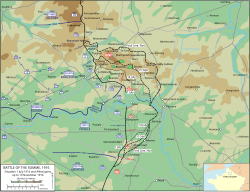| Attack on the Gommecourt Salient | |||||||
|---|---|---|---|---|---|---|---|
| Part of the Battle of the Somme | |||||||
 Battle of the Somme 1 July – 18 November 1916. | |||||||
| |||||||
| Belligerents | |||||||
|
|
| ||||||
| Commanders and leaders | |||||||
| Sir Douglas Haig | Erich von Falkenhayn | ||||||
| Strength | |||||||
| 2 divisions | 5 regiments | ||||||
| Casualties and losses | |||||||
| 6,769 | 1,241 | ||||||
The Attack on the Gommecourt Salient was a British operation against the northern flank of the German 2nd Army. The attack took place on 1 July 1916, on the Western Front in France, during the First World War. The attack was conducted by the British Third Army (Lieutenant-General Edmund Allenby) as a diversion, to protect the northern flank of the main attack. The British Fourth Army on the First day on the Somme, attacked from Serre southwards to the boundary with the French Sixth Army at Maricourt. To extend the attack front of the Fourth Army, the VII Corps (Lieutenant-General Thomas Snow) of the Third Army was to capture the Gommecourt Salient, the most westerly point of the Western Front. In the first week of May, the 56th (1/1st London) Division (Major-General Charles Hull) and the 46th (North Midland) Division (Major-General Edward Montagu-Stuart-Wortley) moved into the area for the attack. By 10 May, both divisions had taken over the front on the right flank of the 37th Division (Major-General Count Gleichen) and begun training for the operation, making no attempt to conceal the preparations.
At 7:30 a.m. on 1 July, the attack on Gommecourt began and the 56th (1st London) Division to the south, overran the first two German trenches. Troops also reached the third trench but a strongpoint at Nameless Farm held out despite several attacks. The German artillery fired a standing barrage along no man's land and trapped the British on the far side all day, as German infantry gradually recaptured the lost trenches; attempts to send reinforcements from the British lines were costly failures. The 46th (North Midland) Division attack on the north side of the salient had even less success, a smoke screen led the attackers to lose direction as their advance was slowed by deep mud. Some parties of the 137th Brigade got into the German front line and parties of the 139th Brigade reached the second line but German small arms and barrage-fire on no man's land by artillery trapped the attackers and isolated them from their supports. The parties who got across no man's land were surrounded and destroyed, a few men being taken prisoner. The 46th (North Midland) Division had the fewest casualties of the 13 British divisions which attacked on 1 July, which got Montagu-Stuart-Wortley sacked (Stellenbosched) on 5 July. After several local truces, the British wounded were got in during 1 and 2 July, after which the area became a backwater.
The Germans retreated from the Bapaume Salient, created by the Battle of the Somme, in February 1917 and abandoned Gommecourt, which was occupied unopposed on 27 February. In 1918, during the Kaiserschlacht (Spring Offensive 1 March – 18 July), the British dug an improvised defensive position, the Purple Line, to the south, east and north of the village but the 62nd (2nd West Riding) Division (Major-General Walter Braithwaite) at Bucquoy to the east stopped the German advance. On 28 March, the 41st Division (Major-General Sydney Lawford) occupied the purple line and a battalion of the 124th Brigade attacked Rossignol Wood. As night fell, the 4th Australian Brigade of the 4th Australian Division to the south of Bucquoy and the 2/8th Battalion, West Yorkshire Regiment, 185th Brigade [62nd (West Riding) Division], attacked the German positions to the south-east. The attack failed but a gap between the Australians and the 186th Brigade was closed and the German threat to Gommecourt removed.
